|

Pages: << Back 6
7 8 9
10 11
12 13 14 Next
>>
Over the years the growing Indiana Asbury faculty had become more
formally organized with its own secretary and treasurer, holding
first weekly meetings and after 1874 bi-monthly meetings. Faculty
members also served as university librarian, and from 1881 on, as
registrar. Professors continued to be assigned odd jobs. In 1882
Professor De Motte was detailed to visit saloons and gambling halls
in town on the lookout for errant students! Professor Alma Holman,
of course, was put in charge of floral arrangements for chapel.
More importantly, the position of university vice-president was always
chosen from faculty ranks, John Clark Ridpath replacing the departing
Tingley in that role in 1879.
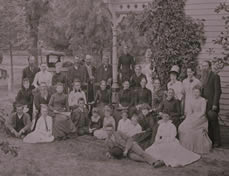 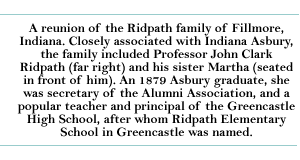
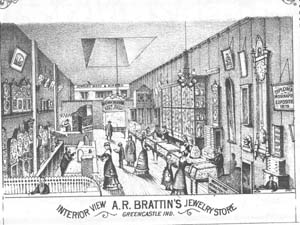
__________________________
Illustration from the 1879
Putnam County Atlas.
__________________________
President Alexander Martin was responsible
for the introduction of student military training on campus in 1876.
After a year of an informal program led by two former Civil
War officers from Indianapolis, in the spring of 1877 the United
States Army assigned Captain D.D. Wheeler as commandant of the newly
organized military department. Upon his arrival on campus Wheeler
found four companies already organized and began drilling them with
arms supplied by the state of Indiana. Under his successor, Lieutenant
William R. Hamilton, two artillery pieces were obtained, and in
the summer of 1882 the Asbury cadets won honors in both artillery
and infantry drill at a military encampment in Indianapolis. Attendance
was required of freshman and sophomore males as well as senior boys
in the preparatory department, but student enthusiasm for the program
was so high many others volunteered. From time to time one or more
companies of young women were even organized. Though Captain Wheeler
tried to raise money for an armory building, the cadets had to be
content with using the old chapel in the
Edifice, which was equipped as an armory-gymnasium in 1882.
Such a program of military training, while probably owing its great
popularity to the recent memories of the Civil
War, also certainly served the demands of a growing interest
in physical fitness.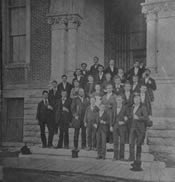
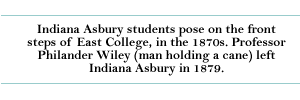
A major post-Civil War change came with
the expansion of the physical plant. Until the mid '70s the essential
college work had been carried on in the Edifice, while preparatory
classes were taught in the old county seminary building, which had
become the property of the university. Town landlords provided adequate
lodging and board for students; hence little thought was given to
building dormitories. In 1870 the cornerstone was laid for the building
eventually called East College,
but its construction was long drawn out because of the slow pace
of fund raising. Some use could be made of it by 1874 and it was
dedicated in 1877. Virtually all college classes and administrative
offices were moved to East College,
while the Edifice continued to house the
college library, the armory, and the gymnasium. The preparatory
department moved into the Edifice when the old county seminary building
was razed to make room for the College Avenue Methodist Church.
In 1879, disaster struck. A fire destroyed virtually all of the
Edifice except the outer walls. Plans were quickly formulated to
reconstruct the old building, and within eight months it was ready
for occupation once more. It had been enlarged by additions on both
east and west, with the main entrance now facing east rather than
north. While the renovated building lacked the peculiar charm of
the old Edifice, the new West College, as it was renamed, gave good
service to the university for the next 50 years.
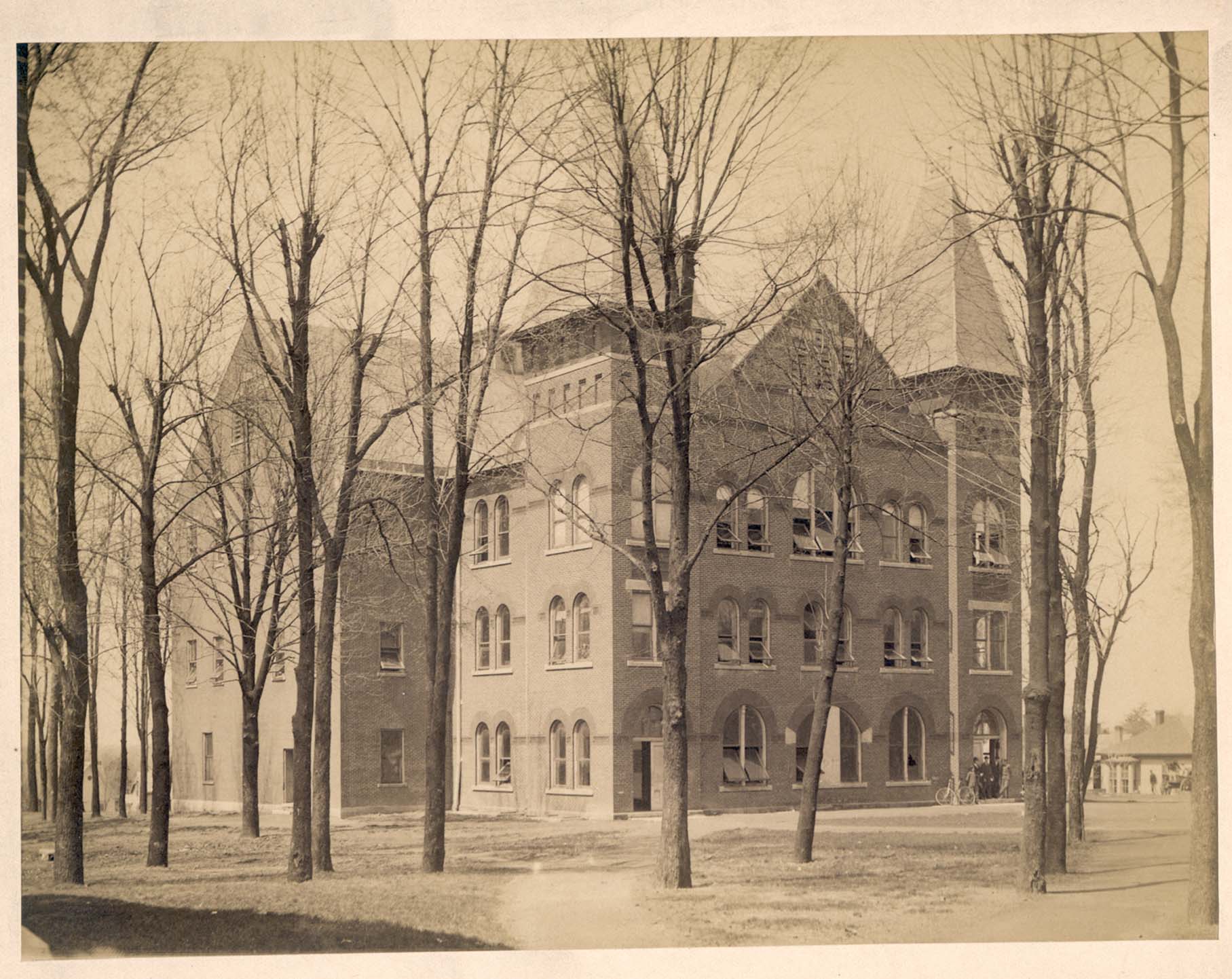
___________________________________
After
the Edifice burned in 1879, it was
quickly rebuilt with additions to the east
and west sides of the building. The "new"
building, called West College, faced east
(while the Edifice had originally faced north.)
___________________________________
The first foreign students were admitted in 1874, when three Brazilians
were recorded in attendance, but little more is known about them.
More significant was the arrival of four Japanese
students in the summer of 1877. They proved to be the vanguard
of a large contingent of Japanese
students who studied at the university in subsequent years.
Religion remained an important element in university life in this
period, with chapel prayers, church attendance, and Sunday afternoon
lectures continuing to be compulsory.
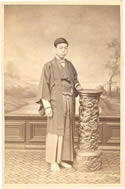 ______________________________________________________________
______________________________________________________________
Izumy Nasu was one of the four Japanese students who came to Asbury
in 1877, when he enrolled in the preparatory department.
Before his death in 1885 he translated parts of the Iliad
into Japanese.
_____________________________________________________
Both students and professors often took part in regular revival
meetings. In 1847 there were 100 conversions in a 10-day period
and about the same number was reported in 1881-82; however, the
overall number of Asbury students had grown by then. A shift from
faculty initiatives in religious observance can be seen, however,
in the formation of a college chapter of the Young Men's Christian
Association in 1879, not long after the first such organization
appeared at Hanover College. Sponsoring such activities as Sunday
school classes and noon prayer meetings as well as evangelistic
meetings in nearby communities, the YMCA quickly became a major
force on campus. Five years later women students formed their own
YWCA chapter, and before long both groups were active participants
in the Student Volunteer Movement, which encouraged its members
to enter the foreign mission field. The late 19th century saw student
piety moving into a more active outward role, as opposed to an emphasis
on personal sanctification. While their zenith has now passed, these
associations proved to be among the most enduring student organizations
the university has known.
Back
to Top
Pages: << Back 6
7 8 9
10 11
12 13 14 Next
>>
|







 ______________________________________________________________
______________________________________________________________